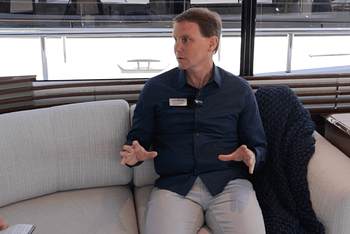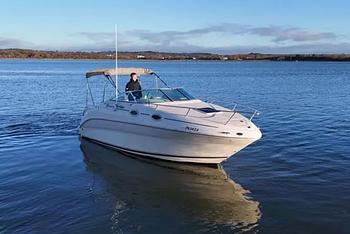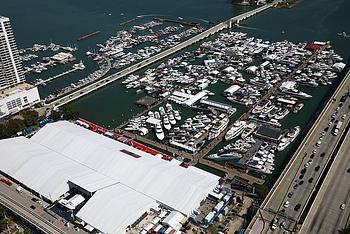In June 2018, the city of London will be blasted by the bellowing shrill of up to twenty racing V6 engines revving at over 10,000rpm. These highly tuned speedsters will then hit 62 mph in less than two seconds before maxing out at 155mph. What follows will be 45 minutes of the most exhilarating and spectacular racing that the city has ever witnessed. Twenty speed jocks, each peering intensely through a tiny windscreen, white-knuckled hands firmly grasping a steering wheel, will unleash 10,000hp of sheer power upon the city. This is Formula 1…but with a big difference. You won’t find Lewis Hamilton Instagramming from the grid, or see Fernando Alonso reclined in his now customary deck chair. They’ll be no talk of tyre compounds or fuel saving. This is F1H20, better known to the punters as Formula 1 Powerboat racing.
Now in its 4th decade, F1 powerboats will return to London for the first time since 1984, taking place during London Tech Week 2018, Europe’s largest festival of technology and innovation. The race will be part of the 38th F1H20 World Championship season. 8 races held across the globe from Abu Dhabi to China to Miami. The event will showcase the cutting edge of powerboat technology and engineering and will be broadcast live on Sky Sports. Welcome to the Formula 1 Powerboat racing- the ultimate adrenaline rush!

Where it all began
Formula 1 Powerboats didn’t have an easy birth. The genesis of the series is a story of change and evolution with multiple promoters and two massive corporations battling to win the right to call themselves Formula 1. The fight would lead to disarray and bitter wrangling amongst competitors and would finally end up in an acrimonious divorce.
The story begins in 1978, when PR manager, David Parkinson was approached by one of his clients, Mercury Marine, who offered to support him if he could establish a single unified championship for inshore powerboats. The resulting race, sponsored by another of Parkinson’s clients, became known as the Canon Trophy. At the same time the concept was launched, there had been an on-going engine war between Mercury Marine and their arch-rivals OMC (Outboard Marine Corporation). OMC favoured 3.5litre V8 that would become known as the OZ class,whilst Mercury offered a standard 2litre power-plant. This was known as the ON class. OZ manufacturers offered drivers a free supply of their engines in a bid to succeed. OZ powered boats with their vastly greater power, easily swept the ON powered craft before them.
Finally, at the Italian Grand Prix, the détente broke when Renato Molinari arrived to compete with two engines in the back of his boat. 28 drivers signed a petition demanding that OZ powered boats be banned giving birth to the Formula ON Drivers Association (FONDA). In 1981, OZ boats and ON boats would have their own championships. OMC would run the OZ class whilst FONDA would run the ON class. However, both championships felt it was their right to be prestigiously titled, Formula 1. In 1981, cigarette manufacturer John Player, chose to sponsor the OZ championship. The sponsorship money resulted in enormous technological and performance advantages over the lower-powered ON boats which were being run effectively as the remains of the Canon Trophy.

The Monaco based international governing body of powerboat racing, Union Internationale Motonautique (UIM), finally stepped in awarding Formula 1 status to the OZ class while the ON class was overshadowed and had to settle for the less prestigious “World Grand Prix” nom de guerre. In common with Formula 1 car racing, Formula 1 Powerboat racing adopted a points system with the top 6 finishers receiving 9, 6, 4, 3, 2, 1 points. With the money pouring in from John Payer, the speeds increased to dangerous levels. This reached a tragic climax in 1984, when Tom Percival was killed in a racing accident.
He was the fourth driver to lose his life in just a few short months. Major sponsor, Carlsberg cancelled their contract for fear of the brand being closely associated with the death or serious injury of another driver. A depleted field finished the 1984 season but it was obvious that the OZ class couldn’t hold on to the Formula 1 moniker much longer in its current state. The series eventually ended in 1986.
There was now the opportunity for the FONDA World Grand Prix Series to take up the mantle of Formula 1. After three years without an official Formula 1 Championship, UIM awarded FONDA Formula 1 status in 1990. Today the boats are powered by Mercury 2.5litre engines which were introduced in 2000, replacing the original 2litre power-plants.
The Powerboats
The early boats were made from plywood with drivers dangerously exposed in an open cockpit with a high risk of serious injury or death. To improve the safety in the new Formula 1 series, boat designer Chris Hodges was brought in. His first contribution to the sport was that of a safety cell made from strong composite material. Hodges’ safety cell was separate from the main structure and was fitted to the hulls and centre section. In a similar manner to the cockpit area of an F1 car, the safety cell was designed to absorb the forces of an impact leaving the wooden hull to break up, whilst the driver remained protected in the cell.
This heralded a revolution in powerboat safety with equipment such as airbags becoming mandatory. It was only now that drivers wore seatbelts. Nowadays composite material has replaced wooden hulls.
Modern Formula 1 Powerboats are tunnel hull catamarans. This design lends to exceptional manoeuvrability and speed. The tunnel hull design creates “lift” in the same way an aeroplane’s wing functions, hence, when they are at high speed only a few inches of the boat actually touches the water. They weigh 860 pounds (390 kilogrammes) of which 260 pounds (118 kilogrammes) is the engine. They are seven feet wide (2 metres) and 20 feet long (6 metres). Weight is kept to a minimum by the use of carbon fibre and Kevlar in the construction process.
A Mercury Marine V6 two stroke engine powers the boat generating over 400hp at 10,500rpm resulting in 0-100kph (62mph) in less than two seconds and a top speed of over 250kpm (155mph). The engines burn through 100LL Avgas at a wallet-shattering rate of 120 litres or 32 gallons, per hour.
The Drivers and Teams
Since 1981, there have been thirty-three Formula 1 Powerboat World Champions, but of these, one man stands head and shoulders above the rest, Guido Cappellini. The most successful powerboat racer in history and the sports equivalent to F1 god, Michael Schumacher, this Italian racer has won ten world titles in the sport. Winning his first title in 1993 and he went on to win the next three years back to back. He retired in 2009 after winning his tenth title and final that year. He’s currently team manager for Team Abu Dhabi Formula 1 powerboat team.
The current champion is a three-times winner, 53-year-old Frenchman, Philippe Chiappe. He’s won all three of his titles driving for the CTIC Shenzhen China Team who he’s driven for since 2010. He began his career in 1998, competing in the French S850 class before moving on to the S3000 class in 2001. He made his debut in Formula 1 in 2003 before returning to win the S3000 class in 2006. His first F1H20 podium was in St. Petersburg in 2009 and first pole position in Abu Dhabi in 2014. By 2015, Chiappe had started 100 Formula 1 Powerboat races. He is one of only four drivers to have won back-to-back championships.
For the 2017 season nine teams of two drivers are competing for the title. The teams and drivers are as follows:
CTIC F1 Shenzhen China
Based in France and managed by Eric Chan. Debuted in 1997.
Drivers: Philippe Chiappe
- Peter Morin
Victory Team
Based in United Arab Emirates and managed by Scott Gillman. Debuted in 2015.
Drivers: Ahmed Al Hameli
- Shaun Torrente
Team Abu Dhabi
Based in United Arab Emirates and managed by Guido Cappellini. Debuted in 1997.
Drivers: Thani Al Qemzi
- Alex Carella
- Rashed Al Qemzi
F1 Atlantic Team
Based in Portugal and manged by Mario Benavente. Debuted in 1999.
Drivers: Grant Trask
- Duarte Benavente
Mad-Croc Baba Racing
Based in Italy and managed by Michael Jenkins. Debuted in 2000.
Drivers: Sami Selio
Filip Roms
Team Sweden
Based in Sweden and managed by Jane Persson. Debuted in 2006.
Drivers: Jonas Andersson
- Erik Stark
Blaze Performance
Based in Italy and managed by Francesco Cantando. Debuted in 1996.
Drivers: Bartek Marszalek
- Francesco Cantando
Emirates Racing Team
Based in United Arab Emirates and managed by Craig Bailey. Debuted in 2015.
Drivers: Marit Stromoy
- Mike Szymura
Maverick F1
Based in France and managed by Jean Vital Deguisne. Debuted in 2015.
Drivers: Beranger Robart
- Cedric Deguisne
- Amaury Jousseaume
Each team usually consists of a manager, two drivers, mechanics, radio coordinator and technical coordinator. Each team operates two boats (plus 1 F4 boat) and associated infrastructure such as workshop trailers, etc.
The Format
Up to ten teams, 20 drivers, engineers and other support staff compete for the Formula 1 Powerboat World Championship. The Grand Prix season 2017, comprises of six races beginning in April in Portugal followed by France, two in China and Abu Dhabi before climaxing in December in Sharjah, U.A.E. The Grand Prix is held over three days.
Day 1 mostly consists of technical scrutineering and registration. The teams must ensure that their craft and associated equipment are in the pits 24 hours before this process begins.
Day 2 begins with a drivers’ briefing and is followed by free practice. Qualifying takes place in the afternoon. The race circuit is approximately 2,000 metres with multiple turns. They are usually located on lakes, rivers, protected bays or inland waterways. The turns can produce a G-force of up to 4.5 in a U-turn at 100mph. Pole position is decided by a three-tier qualifying system in a similar fashion to the one employed in Formula 1 car racing. Q1 is a twenty-minute session with all boats running multiple laps. The fastest 12 progresses to Q2. After a short break, Q2 begins, running for another twenty-minutes. The six fastest boats in Q2 then progresses to the final session, Q3. The top six boats run in reverse order from their fastest Q2 times. They run two laps each to decide their starting positions.
Day 3 is race day and it begins with a drivers’ briefing and then an hour of free practice. The race itself is held in the afternoon with a duration not exceeding 60 minutes. The average race is usually around 45 minutes long, longer than any other powerboat race but substantially shorter than most car races. The Grand Prix weekend ends with the trophy ceremony at 4:00pm.
World Championship points are awarded as follows;
1st - 20 points
2nd - 15 points
3rd - 12 points
4th - 9 points
5th - 7 points
6th - 5 points
7th - 4 points
8th - 3 points
9th - 2 points
10th - 1 point
In addition to the F1H2O race, a support class race made up of F-4 class craft is held. This consists of two single races per weekend. The boats are equipped with Mercury 60hp stock EPA engines and reach a top speed over 120mph. In common with their more powerful big brother, F4s utilise a tunnel hull catamaran design. Many F4 drivers use the class to obtain the super-licence needed to progress to more powerful series such as F2 and F1H20. At a F1H20 Grand Prix weekend, each team must run one F4 boat in the support races.
Osprey Rescue provide safety support at the events. They worked alongside Chris Hodges in the design of the safety cell, testing the device. Their safety boat incorporates a crane which can support the safety cell out of the water keeping rescue times down to a minimum.

With water and wind conditions playing a major part in a race’s outcome, drivers frequently drive “blind” at full tilt in close combat with their competitors. The trick is to “trim” the boat to attempt to control the amount of water flowing through the hull’s tunnels, to increase or decrease the amount of drag. This is achieved by subtly altering the angle of the engine. Teams have up to 40 different propellers of varying “pitch” (angle of the blades) to choose from, depending on conditions. Former world champion and boat designer, American Billy Seebold told the Independent newspaper;
"A Formula One boat is more an aeroplane than it is a boat. The driver is trying to fly it just above the water, working the throttle with the foot, steering it and monitoring a two-litre engine all at the same time."
Get the trim wrong and a driver could be facing being catapulted sky-high. Welsh-born former race winner Jonathan Jones describes the process to E&T.org thus;
"There is a fine line between getting it right and running on a cushion of air and totally losing control. You don't want a lot of contact with the water because it creates drag, but at the same time you need some contact otherwise you lose control of the boat. You are trimming the boat by moving the engine in and out and up and down as you try to get the boat to glide millimetres off the top of the water. Sometimes if you alter the angle by even one or two degrees it is the difference between running the boat perfectly without any drag and getting too much air under the hull causing the boat to blow over.”[1]
The boat is controlled by buttons on the steering wheel which control hydraulic rams that move the engine at the rear of the boat in and out and up and down. The higher the engine is raised more air is trapped inside the hull tunnels the faster the acceleration. The trick is to maintain a balance between keeping enough contact with the water to remain in control whilst minimising the contact to decrease drag. Small increments as little as one or two degrees can have a devastating effect on the handling of the powerboat. Jones went on to describe the technique employed;
"You come out of a corner, you trim the engine out by about 15 degrees, it lifts the nose and you capture the air in the tunnel, accelerate off the corner and try to control the boat to keep as much air in the tunnel. After about 250m you start bringing the nose down by trimming the engine in, which lowers the nose and the boat levels out as you reach top speed. You approach the corner, which is a single turn buoy about half a metre wide and you are only half a metre away, at about 125mph, take the turn and exit at about 100mph. I've measured the lateral G-force at 6.5Gs, but it happens very quickly."
Shortly after winning his third Formula 1 car racing title in 1984, Niki Lauda test drove a Formula 1 powerboat. “It’s like driving a Formula 1 car across a ploughed field”he said. That sums up F1H20 perfectly. It’s exciting, it’s dangerous, it’s exhilarating and it’s ever so slightly bonkers! It’s cutting-edge technology meshed with visceral skills and cool-headedness. Put simply it’s a 400hp two-stroke engine propelling a 390kg catamaran at speeds of over 150mph on a cushion of air and held to the water by mere millimetres of adhesion which could prove the difference between the glory of winning and catastrophic disaster. What’s not to like? Read F1 powerboat - Engineering and Technology



